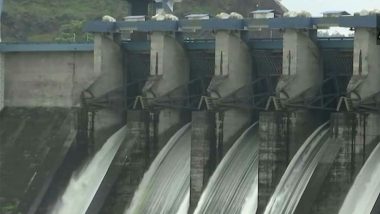Kerala is facing the worst floods since 1924. As heavy rains continue, the shutters of 35 of the 39 dams in Kerala, including the 123-year-old Mullaperiyar Dam, have been opened for the first time in history. The extra water from the reservoirs of the dams has added to the floodwater making situations further difficult for the people. As the situation continues to be grim, the age-old fights between the Kerala and Tamil Nadu governments over Mullaperiyar Dam have intensified. The dam gets water from two rivers, Mulla that flows in Tamil Nadu and Periyar which goes through Kerala.
Talking about the dam, Kerala Chief Minister Pinari Vijayan said the water level reached 142 feet on August 15 after Idukki witnessed heavy rains. He urged the Tamil Nadu government to take share water and bring it down to 139 feet. Vijayan's office said, "To prevent the situation of a sudden release of water in large volumes, which will result in widespread damage, water levels must be lowered immediately." Officials and authorities have been anxious over the condition of the age-old structure as the water levels rose. Kerala Weather Update for Next 48 Hours: IMD Indicates Slight Reduction in Rain Intensity, Relief From Flood
After the governments were at loggerheads, Prime Minister Narendra Modi and Home Minister Rajnath Singh took up the matter. The Mullaperiyar dam, though it is located in Kerala, is operated by Tamil Nadu. It serves the irrigation and power needs of the southern part of Tamil Nadu, besides releasing water into Idukki.
Tamil Nadu has been reluctant to release water between 139 feet and 142 feet citing the Supreme court order that had asked to maintain the water level at 142 feet. However, has been worrying over it as the water level crossed 142 feet. After Vijayan wrote to Tamil Nadu Chief Minister Edappadi K Palaniswami as rains caused havoc in Kerala, the later wrote back to the former assuring that there was no threat to the safety of the Mullaperiyar Dam.
Here are ten things related to the Mullaperiyar Dam:
1. The dam was built for diverting the West-flowing Periyar river eastwards to the dry region of Madurai. The dam stands at the height of 53.66 metres and 365.85 metres in length.
2. It was constructed between 1887 and 1895 in the then princely state of Travancore (present-day Kerala). Under the Periyar Lake Lease Agreement of October 29, 1886, it was given to the neighbouring Madras Presidency on a 999-year lease.
3. The agreement let the neighbouring province construct irrigation projects on the land. However, it was renewed int he 1970s giving Tamil Nadu rights to land and water from the dam; they were also granted authority to develop hydropower projects at the site. In return, Tamil Nadu pays Kerala rent in return.
4. In 1979, following a minor earthquake, local press claimed that there were cracks in the dam. Following the Central Water Commission led by the Government of India conducted a study and recommended lowering the water in the dam's reservoir from 142 feet to 136 feet. Only if definitive measures are implemented, the Tamil Nadu administration could raise water levels to the dam's full capacity of 152 feet.
5. The Tamil Nadu government alleges that although measures were undertaken to strengthen the dam, the Kerala government does not allow rising the water level that causes loses for Madurai farmers who are dependent on it for their farming.
6. Kerala, on the other hand, expressed fears of major devastation for residents living in the earthquake-prone Idukki district. Scientists have also stated that an earthquake above six on the Richter scale in the region can risk the lives of three million people.
7. As talks between the governments on the matter could not find a solution, the Supreme Court in 2006 gave Tamil Nadu legal sanction to raise the water level to 142 feet. But, in response, Kerala amended the 2003 Kerala Irrigation and Water Conservation Act that restricts the water level to 136 feet.
8. Tamil Nadu sought the intervention of the court to strike down Kerala's amendment as unconstitutional. Also, Kerala proposed the construction of a new dam at the site but Tamil Nadu rejected the offer.
9. In 2011, Idukku witnessed minor earthquakes causing further cracks on the dam's surface. In Kerala, violent protests were held against Tamil Nadu following the incident.
10. Following the incident, the top court appointed a committee which after research and study concluded that the dam was "structurally and hydrologically safe". The Tamil Nadu government were told that they can raise water levels to 142 feet. Supreme Court also cancelled the amendment brought to 2003 Kerala Irrigation and Water Conservation Act, calling it unconstitutional. Earlier in 2018, the court directed the Central, Tamil Nadu and Kerala governments to set up three separate panels to prepare for disaster management.
(The above story first appeared on LatestLY on Aug 17, 2018 05:38 PM IST. For more news and updates on politics, world, sports, entertainment and lifestyle, log on to our website latestly.com).













 Quickly
Quickly


